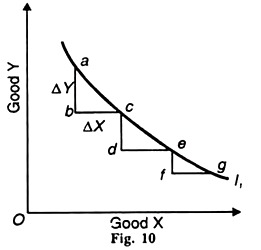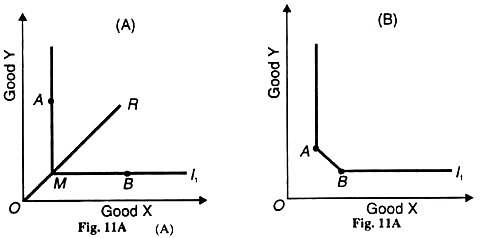The below mentioned article provides an overview on the Marginal Rate of Substitution (MRS).
The marginal rate of substitution is the rate of exchange between some units of goods X and Y which are equally preferred. The marginal rate of substitution of X for Y (MRS)xy is the amount of Y that will be given up for obtaining each additional unit of X. This rate is explained below in the following indifference schedule of Table 2.
To have the second combination and yet to be at the same level of satisfaction, the consumer is prepared to forgo 5 units of Y for obtaining an extra unit of X. The marginal rate of substitution of X for Y is 5:1. The rate of substitution will then be the number of units of Y for which one unit of X is a substitute.
ADVERTISEMENTS:
As the consumer proceeds to have additional units of X, he is willing to give away less and less units of Y so that the marginal rate of substitution falls from 5:1 to 1:1 in the sixth combination (Col. 4). In Fig. 1 above at point M on the indifference curve I1, the consumer is willing to give up 5 units of Y to get an additional unit of X.
As he moves along the curve form M to R, the consumer acquires more of X and less of Y. The amount of Y he is prepared to give up to get additional units of X becomes smaller and smaller. This behaviour of the consumer is known as the principle of diminishing marginal rate of substitution.
Prof. Hicks has defined it in these words:
“Suppose we start with a given quantity of goods, and then go on increasing the amount of X and diminishing that of Y in such a way that the consumer is left neither better off nor worse off on balance, then the amount of Y which has to be subtracted in order to set off a second unit of X will be less than that which has to be subtracted in order to set off the first unit. In the other words, the more X is substituted for Y, the less will be the marginal rate of substitution of X for Y.”
ADVERTISEMENTS:
The marginal rate of substitution of X for Y (MRSXY) is in fact the slope of the curve at a point on the indifference curve. Thus
MRSXY = ∆Y/∆X
It means that MRSXY is the ratio of change in good Y to a given change in X. In Figure 10 there are three triangles on the I1 curves. The vertical sides ab, cd and ef represent AY and the horizontal sides, be, de, and fg signify ∆X. At point c, MRSXY = ab/bc, at e it is cd/de and at point g, MRSXY = ef/fg. This also shows that as the consumer moves downwards along the curve, he possesses additional units of X, and gives up lesser and lesser units of Y, i.e., MRSXY diminishes.
Exceptions:
If the marginal rate of substitution of X for Y or Y for X is diminishing, the indifference curve must be convex to the origin. If it is constant, the indifference curve will be a straight line sloping downwards to the right at a 45° angle to either axis, as in Fig. 7 (B) above.
If the marginal rate of substitution is increasing, the indifference curve will be concave to the origin as in Fig. 7(A). In the case of perfect complementaries MRS is zero, and the indifference curve I, is L shaped as in Fig. 11 (A), whereas ordinary complementaries have a very low rate of substitution on or near the curvature of the curve, as shown in Fig. 11 (B) where the rate of substitution is limited between points A and В on the I, curve. But the straightness, concavity and L shapes of the indifference curves are exceptions to the general principle of the diminishing marginal rate of substitution.
Importance:
The principle of diminishing marginal rate of substitution is superior to the law of diminishing marginal utility. Prof. Hicks regards the replacement of the principle of diminishing marginal utility by the principle of diminishing marginal rate of substitution as a positive change and not a mere translation in the theory of consumer demand. Rightly so.
Because the Marshallian analysis is based on introspective cardinalism in which utility is measured quantitatively and is a single-commodity analysis. The principle of diminishing marginal rate of substitution is, however, scientific and realistic because it is free from the psychological quantitative measurement of utility analysis.
It measures utility ordinally by taking commodities in combinations. In this respect it is superior to the utility concept.


